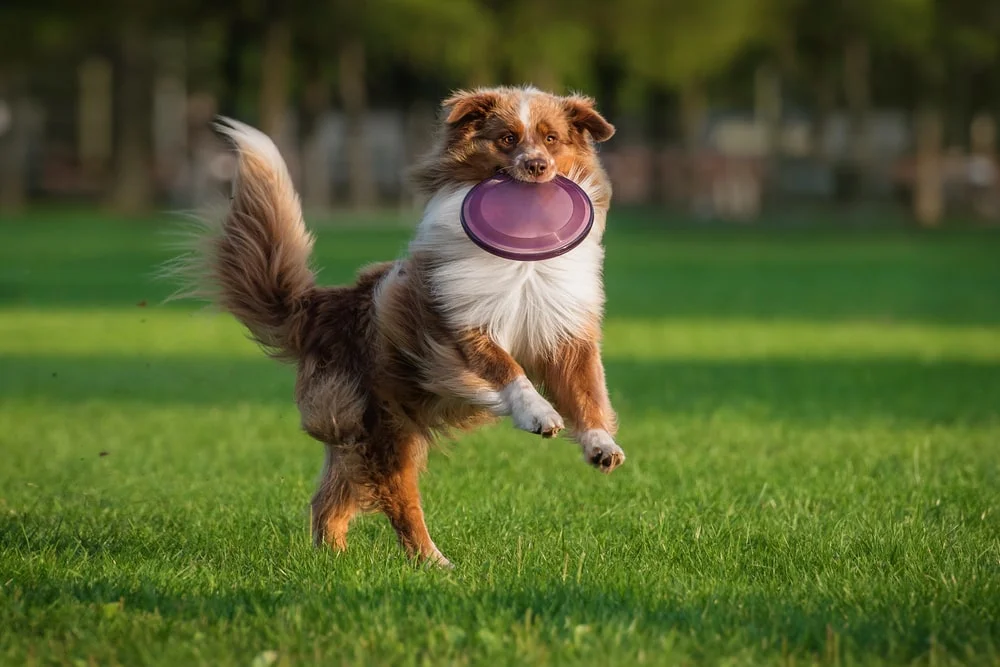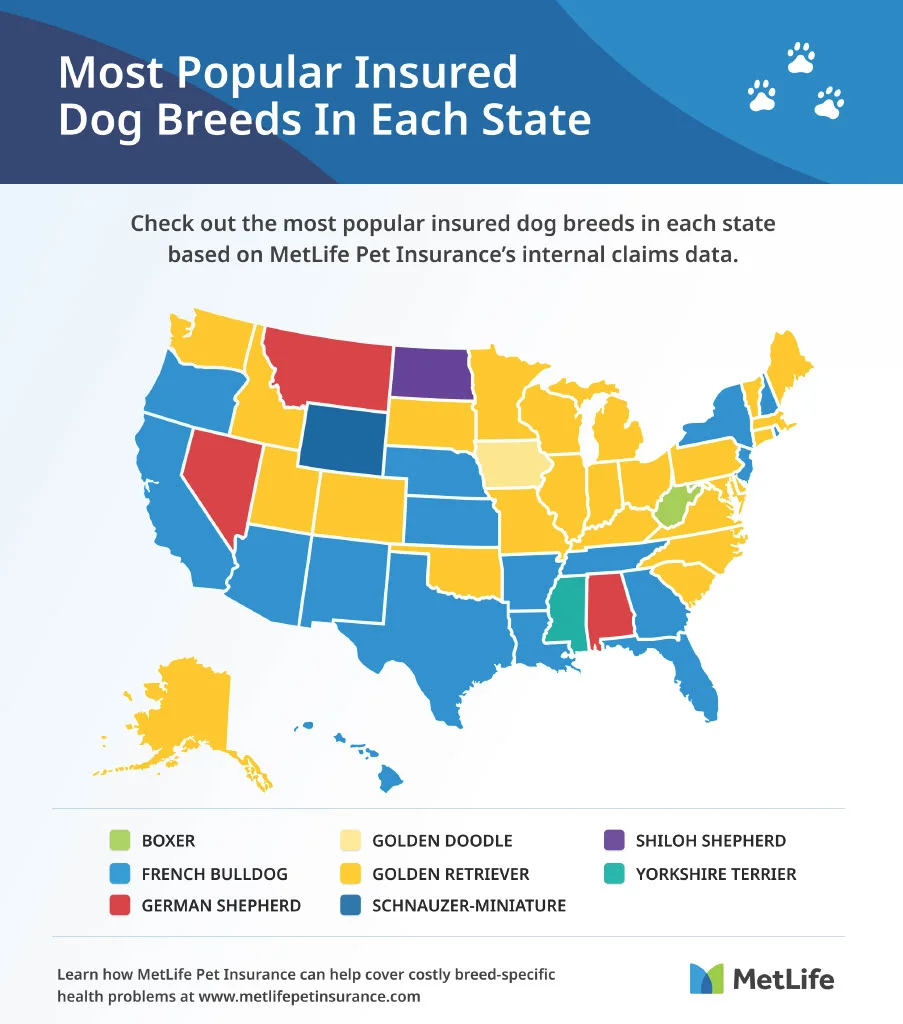With their bright eyes, boundless optimism, and loyal, loving personalities, dogs can melt our hearts. In fact, the American Pet Products Association (APPA) reports that approximately 65 million American households own dogs in 2024.1
If you’re wondering about the most popular dog breeds in your area, we may be able to help. Take a look at our most popular insured breeds by state.
What’s the Most Popular Insured Dog Breed in My State?
MetLife Pet insures dogs of virtually any shape or size across the country. If you’re considering adding a new pal to your family, perhaps our most-insured breed from your state will make the perfect companion.
State |
Most Insured Dog Breed |
French bulldog |
|
French bulldog |
|
Golden retriever |
|
Golden retriever |
|
Golden retriever |
|
French bulldog |
|
French bulldog |
|
French bulldog |
|
French bulldog |
|
Golden retriever |
|
Golden retriever |
|
Golden retriever |
|
French bulldog |
|
Golden retriever |
|
French bulldog |
|
Golden retriever |
|
Golden retriever |
|
Golden retriever |
|
Golden retriever |
|
Golden retriever |
|
Golden retriever |
|
German shepherd |
|
French bulldog |
|
German shepherd |
|
French bulldog |
|
French bulldog |
|
French bulldog |
|
French bulldog |
|
Golden retriever |
|
Shiloh shepherd |
|
Golden retriever |
|
Golden retriever |
|
French bulldog |
|
Golden retriever |
|
French bulldog |
|
Golden retriever |
|
Golden retriever |
|
French bulldog |
|
French bulldog |
|
Golden retriever |
|
Golden retriever |
|
Golden retriever |
|
Golden retriever |
|
Golden retriever |
|
Golden Retrievers: Fun-Loving and Affectionate
One dog that seems to consistently make the list of the most popular dog breeds in the U.S. is the golden retriever. This beautiful, fun-loving, affectionate breed likely traces its roots back to two individual dogs — a “yellow retriever” named Nous and a liver-colored tweed water spaniel named Belle — whom Scotland’s Lord Tweedmouth mated together in 1864.2
The golden retriever is typically good around kids and other dogs. They’re also serious workers who can do anything from hunting and fieldwork to being guide dogs for the blind and aiding in search and rescue. They’re often quite energetic, enjoy outdoor play, and need a lot of exercise.2 While they’re a generally healthy breed, they may suffer from heart problems, various eye issues, and hip dysplasia. Weekly ear checks, along with regular dental cleanings and grooming, are great ways to help them feel their best.3
French Bulldogs: Friendly and Alert
It may surprise you to learn that part of the French bulldog’s family tree likely originates in Great Britain. When English lacemakers relocated to France during the Industrial Revolution, many brought along their toy bulldogs. Over generations, the toy bulldogs crossbred with other dogs — likely terriers and pugs — and later generations began to develop the French bulldog’s trademark features. They eventually became popular in France and earned the name “Bouledogue Français.”4
French bulldogs typically have square, wrinkled heads, stocky legs, smooth coats, and short noses, but their most recognizable feature is their pointed bat ears. They’re typically quite affectionate and good with kids and usually love to make friends with other people and pets. They make great companions, and even though they don’t bark a lot, they’re very alert, which makes them good watchdogs. Because of their flat faces, they may suffer from breathing issues. They may also have a sensitivity to anesthesia and tend to suffer from eye issues — such as cataracts, as well as skin disorders.4
German Shepherds: Protective and Hard-Working
Courageous, confident, smart. The American Kennel Club (AKC) uses those three words to describe German shepherds. The breed is often considered one of the finest working dogs, and their history certainly helps support that idea.5,6
As a cavalry officer in the 19th century, Max Emil Friedrich von Stephanitz was very impressed by the sheepdogs he saw in the German countryside. Having previously studied veterinary science, von Stephanitz eventually decided to harness these dogs’ traits to create a formal German sheepdog. While attending a dog show in 1899, he spotted a dog named Hektor Linksrhein. Hektor had a striking, wolf-like appearance and was deeply intelligent, which led to von Stephanitz purchasing him. When von Stephanitz later started the first official German shepherd club, Hektor — now renamed Horand von Grafrath — received the first registration number and effectively became the first official German shepherd. Most of today’s German shepherds likely descend from Horand.6
German shepherds are prized working dogs known for being affectionate and good around kids.5,6 They’ll often be very protective of those they love and can be wary of strangers. These traits usually make them good protectors. While they’re generally healthy, they are prone to ear infections. They may also suffer from bloat, a potentially life-threatening swelling of the abdomen. They also require a lot of exercise, and it’s a good idea to always keep them on a leash.5
Shiloh Shepherds: A Unique, Rare Breed
Several decades ago, Tina Barber of New York began trying to breed her own ideal German shepherd. Eventually, her selectively bred dogs began to diverge from the standards of ordinary German shepherds.7 The American Rare Breed Association (ARBA) recognized Shiloh shepherds as a separate rare breed in 1991.7,8
Shiloh shepherds are generally a courageous, gentle, and very loving breed — although, they can sometimes display aloofness, timidity, and sullenness. They’re usually very faithful, intelligent, and protective of their homes and families, which may make them good fits as service dogs and watchdogs. They have efficient movements, elegant gaits, and stocky builds, along with straight backs, pointed ears, and bushy tails. Their deep chests may make them prone to conditions like bloat. They may also face challenges like hip dysplasia, elbow dysplasia, and heart problems. However, they’re athletic, energetic, and often make great outdoor companions. Still, they tend to remain calm indoors.7,8
Is Paying Your Dog’s Vet Bills Getting Hairy?
Goldendoodles: The Best of Two Breeds
The goldendoodle is a relatively new breed, emerging in the 1960s from the crossbreeding of golden retrievers and poodles. Interestingly, they were initially created as guide dogs, but they became popular household pets in the 1990s. They’re gentle, loving, make great companion dogs, and rarely meet a friend they don’t like.9
Because they’re a crossbreed, goldendoodles can exhibit the traits of both golden retrievers and poodles. They may vary in size depending on what poodle they descend from, with mini goldendoodles averaging 13 – 20 inches in height, and standard goldendoodles averaging 20 – 24 inches. While their descent from retrievers may make them shed, their descent from poodles often makes them hypoallergenic. They may also be prone to certain illnesses from both sets of genes. These include cardiac issues, epilepsy, and hip dysplasia. It’s important to give them brisk exercise daily.9
Yorkshire Terriers: Loving and Energetic
The Yorkshire terrier (commonly called the Yorkie) is an affectionate, energetic toy breed that makes an excellent companion. While they were initially used as rat catchers in English mills and mines, their small size — they tend to only weigh about 7 pounds — and lively personalities made them popular lap dogs in the Victorian Era. Their trademark feature is their long, silky coat, although they still have the courage of the terrier.10
While Yorkshire terriers are highly trainable, they can sometimes be feisty and bossy. They can also be a bit territorial around other dogs, which may make them good watchdogs (despite their diminutive size). They require mental and physical stimulation, although they’re also great with children. They may suffer from eye conditions, a knee condition known as luxating patella, and periodontal disease, although they often live long lives.10
Boxers: Sturdy and Brave
A brave and intelligent breed, boxers are quite recognizable for their sturdy frames and athletic builds. They’re often very muscular and powerful, but they still emulate gracefulness. While they have ancestry that may date back as far as 2,500 B.C., breeders likely created the current form of the breed from a larger German dog called the “bullenbeisser” (“bull biter”).11
Boxers typically have short, sleek coats, broad heads, square jaws, and long jowls. They often make great family dogs and are brave in the face of threats. However, they may not fully mature past the puppy phase until they’re 3 – 4 years old.12 It’s generally a good idea to begin socialization while they’re still puppies. They may experience hip dysplasia, heart issues, and certain cancers, but one of the most important things to note about them is they’re often sensitive to heat and cold.11
Miniature Schnauzers: Strong and Smart
A member of the broader terrier group, the miniature schnauzer is a friendly, smart, energetic, and affectionate breed that often makes a great family companion. They likely have no connection to English terrier breeds, instead originating in continental Europe. Their ancestors are likely standard schnauzers, poodles, and affenpinschers whom German farmers bred to a smaller size to act as rat catchers in barns. Even today, miniature schnauzers remain fearless hunters.13
The miniature schnauzer’s trademark features are its beard, bushy eyebrows, and muscular build. Even though they don’t produce much dander, they can still have wiry coats. As a result, they may require frequent brushing and regular grooming. They may suffer from various conditions — such as cataracts, a skeletomuscular disorder called myotonia congenita, and a blood clotting illness called Von Willebrand disease.13
MetLife Pets Can Help Protect Dogs of All (Stars and) Stripes
No matter what state you live in or what kind of dog you have, MetLife Pet knows how important your best pal’s care likely is to you. Our dog insurance policies come with no breed restrictions, so you don’t have to worry about whether your pet qualifies because of the type of dog they are. By getting covered, you can help your furry friend get the care they need and protect your wallet in the meantime. Don’t wait to get started. Request your free custom quote today.



